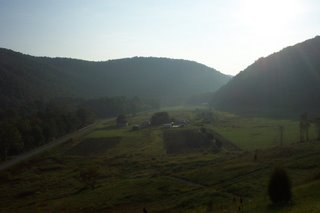 There seemed to be deer everywhere, I saw them along hillsides, mountaintops, and valley bottoms. Every so often a small settlement or homestead was seen. They all seem isolated, self-contained, and rather cut off from the wider world. In a sense, these homesteads are closed-systems where most foodstuffs are collected and consumed locally. Every little homestead seems to have at least some land being farmed and some domesticated animals. Every settlement seemed to possess either windmills, water-wheels, or solar panels. One cannot help but envy these smallholders, their societies have far greater sustainability than the Mega-cities and suburbs that we live in.
There seemed to be deer everywhere, I saw them along hillsides, mountaintops, and valley bottoms. Every so often a small settlement or homestead was seen. They all seem isolated, self-contained, and rather cut off from the wider world. In a sense, these homesteads are closed-systems where most foodstuffs are collected and consumed locally. Every little homestead seems to have at least some land being farmed and some domesticated animals. Every settlement seemed to possess either windmills, water-wheels, or solar panels. One cannot help but envy these smallholders, their societies have far greater sustainability than the Mega-cities and suburbs that we live in.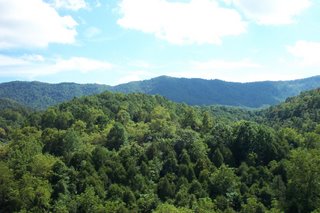 By early afternoon, I had crossed from West Virginia into the Tennesse border. Quickly speeding past Knoxville, I caught sight of several M1-Abrahm Tanks along with an unmanned Robotic Predator Drone. It appears that through a quirk of planning a pre-industrial era society is existing alongside an information age military. In anycase, I drove onwards. Past Knoxville, the Smokey mountains region was at last reached. After driving ever deeper into those mountains, I arrived at the small village of Robbins. 10 Miles west of that village, I came upon my hunting lodge, located at the absolute center of nowhere.
By early afternoon, I had crossed from West Virginia into the Tennesse border. Quickly speeding past Knoxville, I caught sight of several M1-Abrahm Tanks along with an unmanned Robotic Predator Drone. It appears that through a quirk of planning a pre-industrial era society is existing alongside an information age military. In anycase, I drove onwards. Past Knoxville, the Smokey mountains region was at last reached. After driving ever deeper into those mountains, I arrived at the small village of Robbins. 10 Miles west of that village, I came upon my hunting lodge, located at the absolute center of nowhere.After getting in touch with my hunting guide Lathern, I settled down in that little lodge. Lathern mentioned that early tomorrow we should try out my boar hunting weapons: the rifle and long bow before proceeding to hunt.
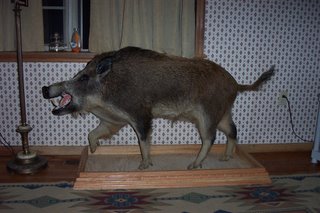 For apparently, the wild boar has some major differences in physiology when compared to the domesticated pig. Some 6,000 years ago, the wild and domesticated hog would've been identical. But humanity stepped in and modified the basic structure of the pig. The tusks and fangs for hunting were the first features to cull. It's thick, furry hide was then selectively breed out in favor of a hairless varient for ease of butchering. It's brain was then bred to be smaller and smaller to the point where the domestic pig's average brain size is 2/3 that of the wild varient. Wild boars have 2 thick bone/hard cartilage plates extending from the base of it's spinal column down to it's rib cage, these bone plates protect the boar from his prey and from other boars. Humans bred out the feature entirely so that domestic hogs have only small vestigial plates of soft(edible) cartilage.
For apparently, the wild boar has some major differences in physiology when compared to the domesticated pig. Some 6,000 years ago, the wild and domesticated hog would've been identical. But humanity stepped in and modified the basic structure of the pig. The tusks and fangs for hunting were the first features to cull. It's thick, furry hide was then selectively breed out in favor of a hairless varient for ease of butchering. It's brain was then bred to be smaller and smaller to the point where the domestic pig's average brain size is 2/3 that of the wild varient. Wild boars have 2 thick bone/hard cartilage plates extending from the base of it's spinal column down to it's rib cage, these bone plates protect the boar from his prey and from other boars. Humans bred out the feature entirely so that domestic hogs have only small vestigial plates of soft(edible) cartilage.Knowing that wild boars will have the advantage of tusks and fangs, thick hide and bone armor, I at once began preparing my weapons.
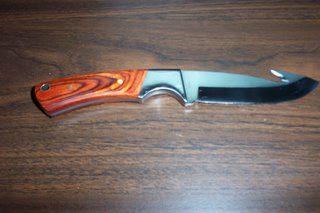 The hunting knife, the weapon of last resort, was sharpened until it took on a wicked edge. I made sure that my rifle was clean and well oiled. My home-made ammunition was examined and re-examined for defects. Each and every bullet was precision loaded to be able to consistently hit a quarter at 100 yards. My hand-crafted ash arrows were all spined to within a pound of the bow that it'll be shot from. These spined shafts were then braced with Turkey feathers for flight stabilization, after which, a coating of tallow was applied to prevent wood-warping.
The hunting knife, the weapon of last resort, was sharpened until it took on a wicked edge. I made sure that my rifle was clean and well oiled. My home-made ammunition was examined and re-examined for defects. Each and every bullet was precision loaded to be able to consistently hit a quarter at 100 yards. My hand-crafted ash arrows were all spined to within a pound of the bow that it'll be shot from. These spined shafts were then braced with Turkey feathers for flight stabilization, after which, a coating of tallow was applied to prevent wood-warping.Each arrow was tipped with a triple-bladed carbon steel broadhead. These broadheads, I sharpened on a soapstone until each carbon-steel edge could slice through a piece of paper. Then the edges were coated with a thin layer of vegetable oil to aid in the smooth penetration of flesh and bone.
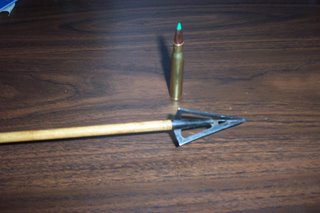
A precisely spined arrow will consistently hit a pie plate at 40 yards. A sharpened heavy broadhead will slice entirely through the upper torso of large animals like deer or goat out to 30 yards. With my weapons in a state of extreme readiness, I felt at last ready for the hunt tomorrow.
No comments:
Post a Comment